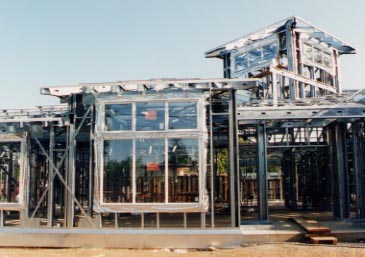Coaching
Healthy House Windows
For our healthy house, we used aluminum double-pane windows with a thermal break. The thermal break is important not only from an energy efficiency standpoint, but also because it reduces cold spots on the inside, thereby limiting condensation and the resulting mold growth. The windows we selected were made by Milgard.
The windows were installed after the roof was enough in place to protect them from further rain. The installation began by attaching builders foil to the framing surrounding the window opening with Polyken aluminum tape. Then a bead of 100% silicone caulk was applied around the perimeter of the window opening, on top of the foil. The foil would become part of the wind barrier on the outside of building, under the siding. After the caulk was applied, the windows were attached to the frame with stainless steel screws to avoid future mixed-metal corrosion problems with the steel framing.

For the type of house we were building, ideally none of the windows should be able to be opened, since that would let in unconditioned, unfiltered air from the outside. However, local building codes require fire egress capability in the bedrooms, and we decided to have a number of other windows be openable in case of a failure of our ventilation system, or a kitchen grease fire or something similar.
The architect had originally designed the windows to have 3" wide frames around them on the outside. Unfortunately, neither Milgard nor the siding manufacturer makes a trim piece that size. In order to get the look that the architect had in mind, the trim would have to have been custom made. As a cost-saving measure, we decided not to do it. However, now that the house is done, we can see that it really would have looked much better to have the wider trim.
The exterior doors were also installed at about this time. The doors are made of aluminum, with large glass panes. We had a difficult time finding a reasonably priced metal door. One brand that we looked at was over $1,000 per door, unpainted and without glass. The ones we ended up using were made by Blomberg Doors. Like the windows, they are painted with a factory-applied baked-on white paint. They also come from the factory with a handle, lockset, hinges and trim. They are very attractive, and they nicely complement the Milgard windows. They were installed in a way similar to the windows, with a bead of 100% silicone caulk around the perimeter to form an airtight seal.
The interior doors are solid maple. We chose a 2-panel style. They were custom made for us, using only standard yellow wood glue. We had some difficulty locating a durable, non-toxic finish for the doors. We finally decided on Crystal Aire, which is made by Pace Chem. This product is very smelly and toxic while it's being applied. However, it dries fast, and is completely non-toxic and odor-free afterwards. To make sure that the fumes weren't absorbed into the walls of the house, we had the doors finished in the garage, with maximum ventilation.

Articles
diagnosis
detective
MCS/EI/CFIDS
protocol
oxygen O2MT
Healthy House
guidelines
location
foundation
floorplan
framing
flooring
electrical
plumbing
roofing
windows
siding
kitchen
Supplements
carnitine
cetyl myrist.
coq10
d-glucarate
glucosamine
IP6
Lipoic Acid
Vitamin E